1998 OPEL FRONTERA air condition
[x] Cancel search: air conditionPage 4886 of 6000
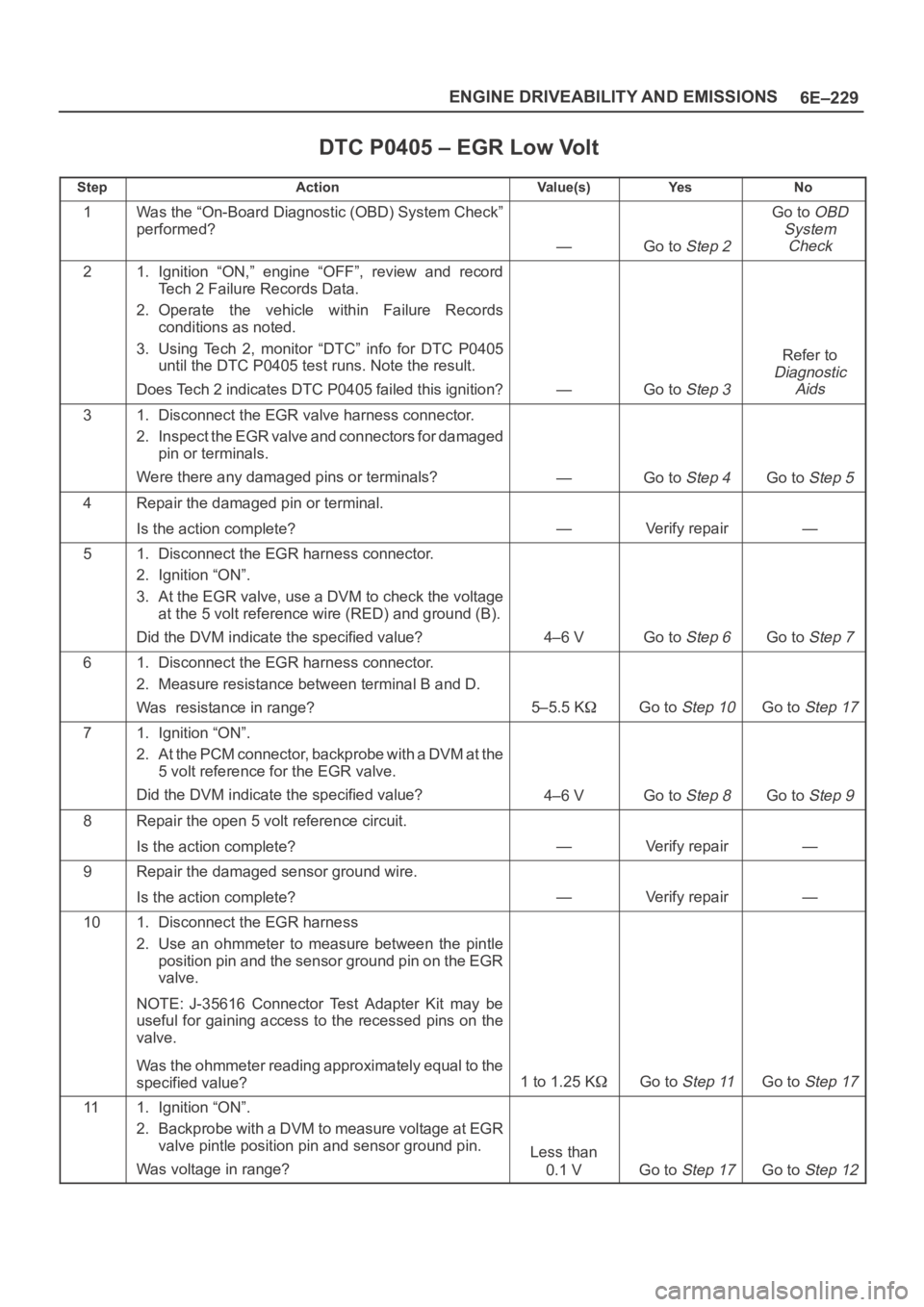
6E–229 ENGINE DRIVEABILITY AND EMISSIONS
DTC P0405 – EGR Low Volt
StepActionVa l u e ( s )Ye sNo
1Was the “On-Board Diagnostic (OBD) System Check”
performed?
—Go to Step 2
Go to OBD
System
Check
21. Ignition “ON,” engine “OFF”, review and record
Tech 2 Failure Records Data.
2. Operate the vehicle within Failure Records
conditions as noted.
3. Using Tech 2, monitor “DTC” info for DTC P0405
until the DTC P0405 test runs. Note the result.
Does Tech 2 indicates DTC P0405 failed this ignition?
—Go to Step 3
Refer to
Diagnostic
Aids
31. Disconnect the EGR valve harness connector.
2. Inspect the EGR valve and connectors for damaged
pin or terminals.
Were there any damaged pins or terminals?
—Go to Step 4Go to Step 5
4Repair the damaged pin or terminal.
Is the action complete?
—Verify repair—
51. Disconnect the EGR harness connector.
2. Ignition “ON”.
3. At the EGR valve, use a DVM to check the voltage
at the 5 volt reference wire (RED) and ground (B).
Did the DVM indicate the specified value?
4–6 VGo to Step 6Go to Step 7
61. Disconnect the EGR harness connector.
2. Measure resistance between terminal B and D.
Was resistance in range?
5–5.5 KGo to Step 10Go to Step 17
71. Ignition “ON”.
2. At the PCM connector, backprobe with a DVM at the
5 volt reference for the EGR valve.
Did the DVM indicate the specified value?
4–6 VGo to Step 8Go to Step 9
8Repair the open 5 volt reference circuit.
Is the action complete?
—Verify repair—
9Repair the damaged sensor ground wire.
Is the action complete?
—Verify repair—
101. Disconnect the EGR harness
2. Use an ohmmeter to measure between the pintle
position pin and the sensor ground pin on the EGR
valve.
NOTE: J-35616 Connector Test Adapter Kit may be
useful for gaining access to the recessed pins on the
valve.
Was the ohmmeter reading approximately equal to the
specified value?
1 to 1.25 KGo to Step 11Go to Step 17
111. Ignition “ON”.
2. Backprobe with a DVM to measure voltage at EGR
valve pintle position pin and sensor ground pin.
Was voltage in range?
Less than
0.1 V
Go to Step 17Go to Step 12
Page 4889 of 6000

6E–232
ENGINE DRIVEABILITY AND EMISSIONS
DTC P0406 – EGR High Voltage
StepActionVa l u e ( s )Ye sNo
1Was the “On-Board Diagnostic (OBD) System Check”
performed?
—Go to Step 2
Go to OBD
System
Check
21. Ignition “ON,” engine “OFF”, review and record
Tech 2 Failure Records Data.
2. Operate the vehicle within Failure Records
conditions as noted.
3. Using Tech 2, monitor “DTC” info for DTC P0406
until the DTC P0406 test runs. Note the result.
Does Tech 2 indicates DTC P0406 failed this ignition?
—Go to Step 3
Refer to
Diagnostic
Aids
31. Disconnect the EGR valve harness connector.
2. Inspect the EGR valve and connectors for damaged
pin or terminals.
Were there any damaged pins or terminals?
—Go to Step 4Go to Step 5
4Repair the damaged pin or terminal.
Is the action complete?
—Verify repair
Is the action
complete?
51. Disconnect the EGR harness connector.
2. Ignition “ON”.
3. At the EGR valve, use a DVM to check the voltage
at the 5 volt reference wire (RED).
Did the DVM indicate the specified value?
4–6 VGo to Step 8Go to Step 6
61. Ignition “ON”.
2. At the PCM connector, backprobe with a DVM at the
5 volt reference for the EGR valve.
Did the DVM indicate the specified value?
4–6 VGo to Step 7Go to Step 16
7Repair the open 5 volt reference circuit
Is the action complete?
—Verify repair—
81. Ignition “OFF”
2. Disconnect the EGR harness.
3. Use a DVM to check for an resistance between D (5
V reference) and B (Sensor Ground) at EGR sensor
terminals.
NOTE: J-35616 Connector Test Adapter Kit may be
useful for gaining access to the recessed pins on the
valve.
Was there measured resistance in range?
5 to 5 KGo to Step 9Go to Step 15
91. Ignition “OFF”.
2. Disconnect the EGR harness.
3. Use a DVM to check for an resistance between B
and C at EGR sensor terminal.
Was there open circuit?
—Go to Step 15Go to Step 10
101. Ignition “OFF”.
2. Disconnect the EGR harness at PCM connector.
3. Use a DVM to check for shorted wire between A1
and B7.
Was there shorted wire?
—Go to Step 14Go to Step 11
Page 4891 of 6000
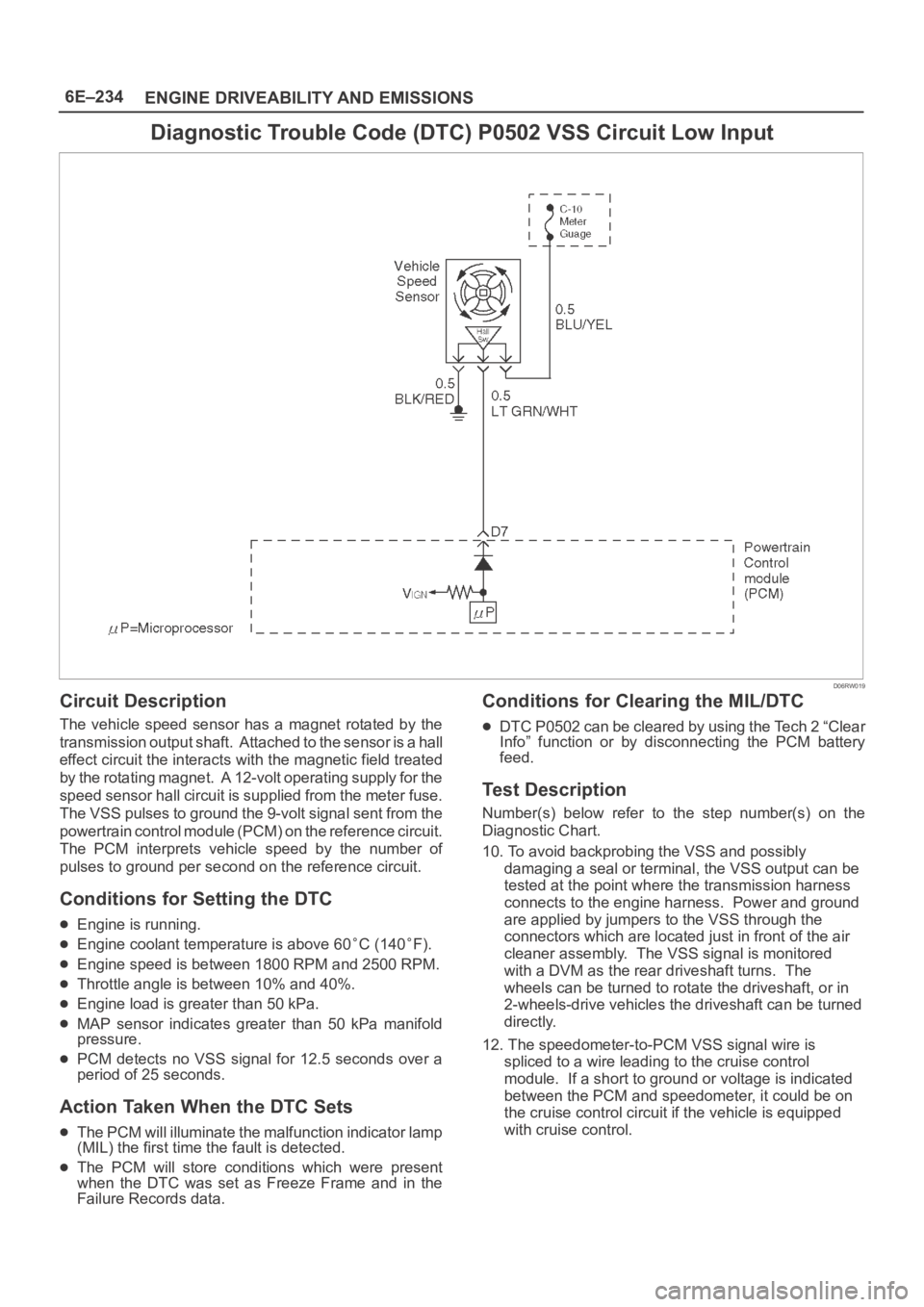
6E–234
ENGINE DRIVEABILITY AND EMISSIONS
Diagnostic Trouble Code (DTC) P0502 VSS Circuit Low Input
D06RW019
Circuit Description
The vehicle speed sensor has a magnet rotated by the
transmission output shaft. Attached to the sensor is a hall
effect circuit the interacts with the magnetic field treated
by the rotating magnet. A 12-volt operating supply for the
speed sensor hall circuit is supplied from the meter fuse.
The VSS pulses to ground the 9-volt signal sent from the
powertrain control module (PCM) on the reference circuit.
The PCM interprets vehicle speed by the number of
pulses to ground per second on the reference circuit.
Conditions for Setting the DTC
Engine is running.
Engine coolant temperature is above 60C (140F).
Engine speed is between 1800 RPM and 2500 RPM.
Throttle angle is between 10% and 40%.
Engine load is greater than 50 kPa.
MAP sensor indicates greater than 50 kPa manifold
pressure.
PCM detects no VSS signal for 12.5 seconds over a
period of 25 seconds.
Action Taken When the DTC Sets
The PCM will illuminate the malfunction indicator lamp
(MIL) the first time the fault is detected.
The PCM will store conditions which were present
when the DTC was set as Freeze Frame and in the
Failure Records data.
Conditions for Clearing the MIL/DTC
DTC P0502 can be cleared by using the Tech 2 “Clear
Info” function or by disconnecting the PCM battery
feed.
Test Description
Number(s) below refer to the step number(s) on the
Diagnostic Chart.
10. To avoid backprobing the VSS and possibly
damaging a seal or terminal, the VSS output can be
tested at the point where the transmission harness
connects to the engine harness. Power and ground
are applied by jumpers to the VSS through the
connectors which are located just in front of the air
cleaner assembly. The VSS signal is monitored
with a DVM as the rear driveshaft turns. The
wheels can be turned to rotate the driveshaft, or in
2-wheels-drive vehicles the driveshaft can be turned
directly.
12. The speedometer-to-PCM VSS signal wire is
spliced to a wire leading to the cruise control
module. If a short to ground or voltage is indicated
between the PCM and speedometer, it could be on
the cruise control circuit if the vehicle is equipped
with cruise control.
Page 4896 of 6000
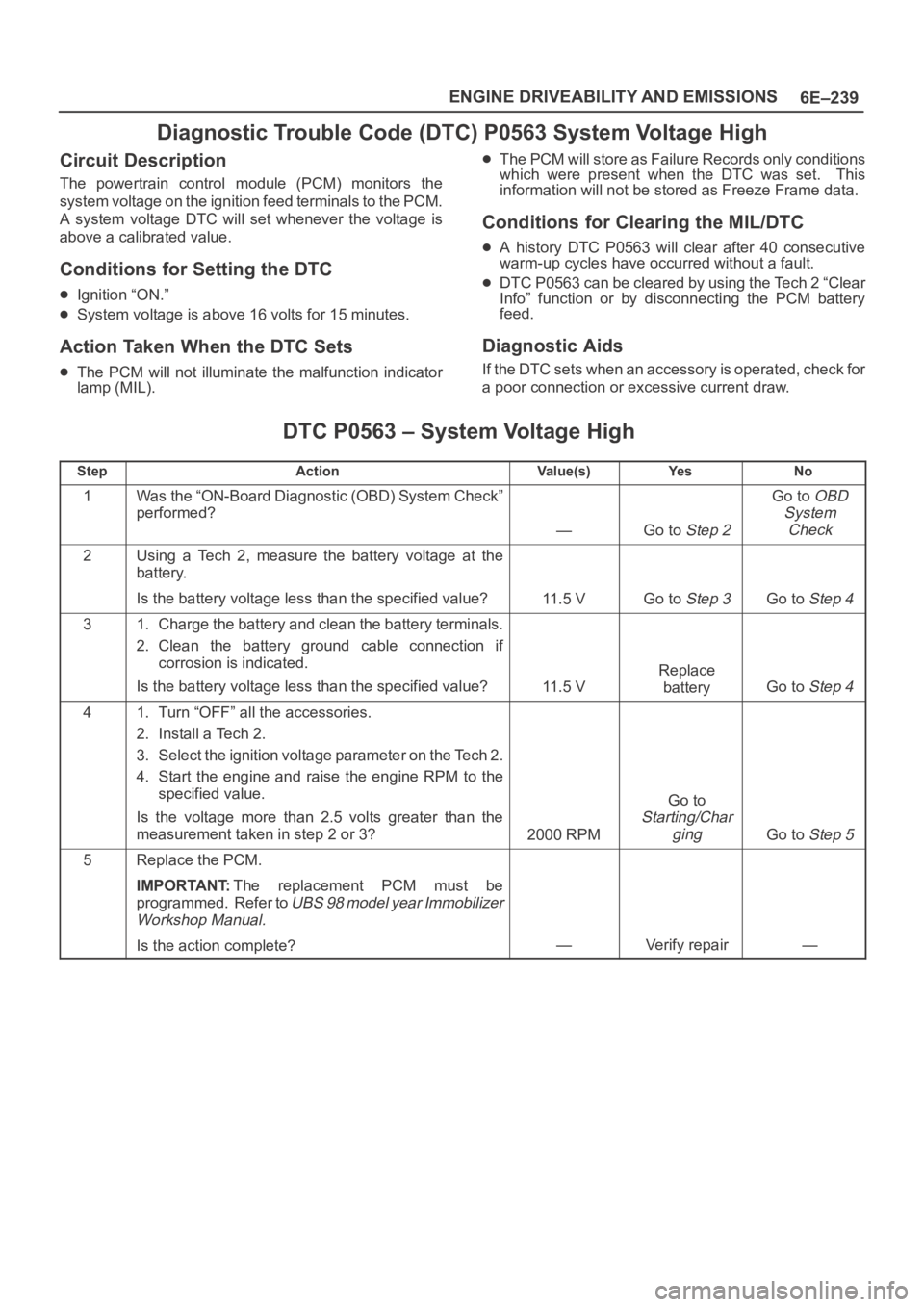
6E–239 ENGINE DRIVEABILITY AND EMISSIONS
Diagnostic Trouble Code (DTC) P0563 System Voltage High
Circuit Description
The powertrain control module (PCM) monitors the
system voltage on the ignition feed terminals to the PCM.
A system voltage DTC will set whenever the voltage is
above a calibrated value.
Conditions for Setting the DTC
Ignition “ON.”
System voltage is above 16 volts for 15 minutes.
Action Taken When the DTC Sets
The PCM will not illuminate the malfunction indicator
lamp (MIL).
The PCM will store as Failure Records only conditions
which were present when the DTC was set. This
information will not be stored as Freeze Frame data.
Conditions for Clearing the MIL/DTC
A history DTC P0563 will clear after 40 consecutive
warm-up cycles have occurred without a fault.
DTC P0563 can be cleared by using the Tech 2 “Clear
Info” function or by disconnecting the PCM battery
feed.
Diagnostic Aids
If the DTC sets when an accessory is operated, check for
a poor connection or excessive current draw.
DTC P0563 – System Voltage High
StepActionVa l u e ( s )Ye sNo
1Was the “ON-Board Diagnostic (OBD) System Check”
performed?
—Go to Step 2
Go to OBD
System
Check
2Using a Tech 2, measure the battery voltage at the
battery.
Is the battery voltage less than the specified value?
11 . 5 VGo to Step 3Go to Step 4
31. Charge the battery and clean the battery terminals.
2. Clean the battery ground cable connection if
corrosion is indicated.
Is the battery voltage less than the specified value?
11 . 5 V
Replace
battery
Go to Step 4
41. Turn “OFF” all the accessories.
2. Install a Tech 2.
3. Select the ignition voltage parameter on the Tech 2.
4. Start the engine and raise the engine RPM to the
specified value.
Is the voltage more than 2.5 volts greater than the
measurement taken in step 2 or 3?
2000 RPM
Go to
Starting/Char
ging
Go to Step 5
5Replace the PCM.
IMPORTANT:The replacement PCM must be
programmed. Refer to
UBS 98 model year Immobilizer
Workshop Manual.
Is the action complete?—Verify repair—
Page 4897 of 6000
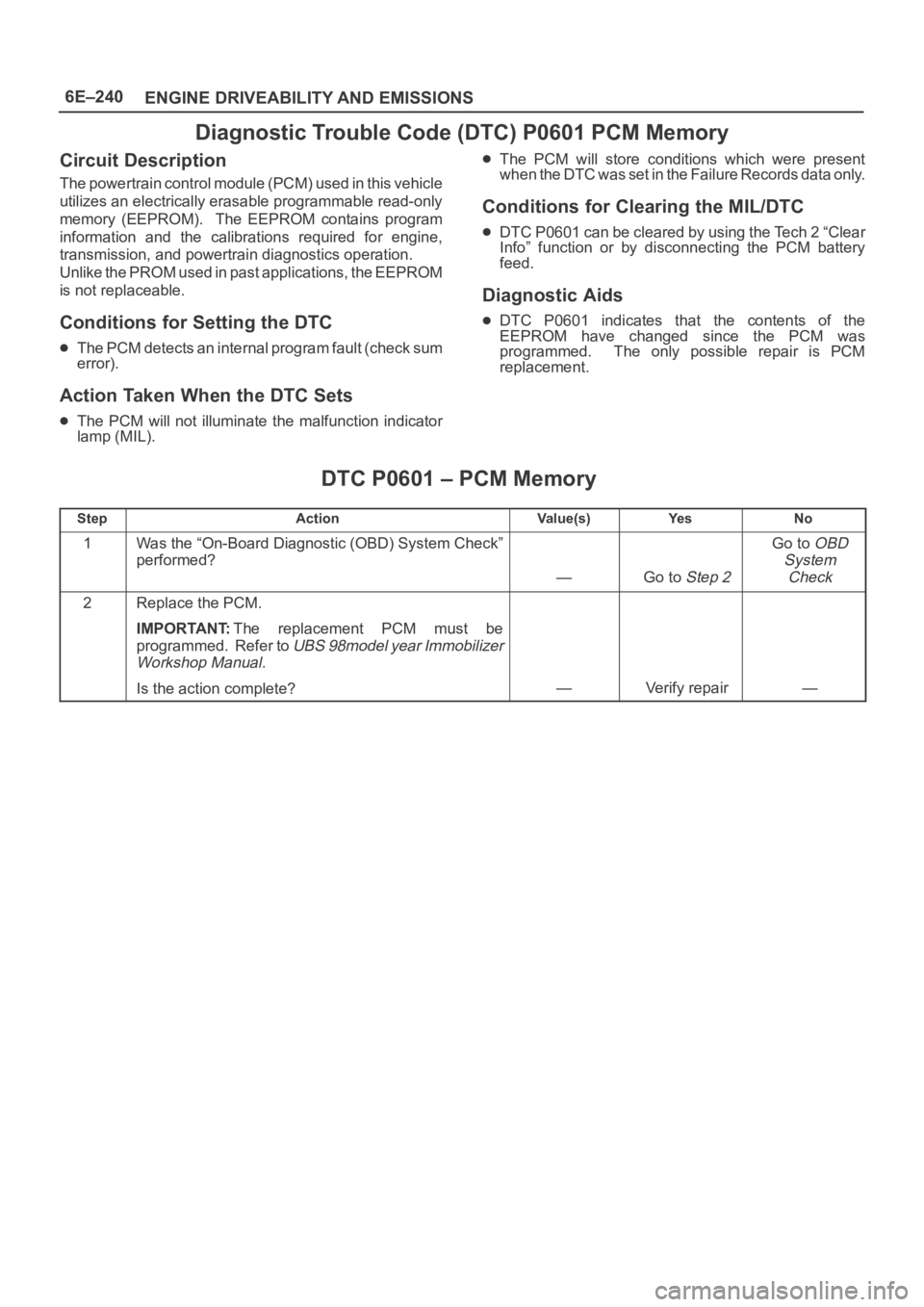
6E–240
ENGINE DRIVEABILITY AND EMISSIONS
Diagnostic Trouble Code (DTC) P0601 PCM Memory
Circuit Description
The powertrain control module (PCM) used in this vehicle
utilizes an electrically erasable programmable read-only
memory (EEPROM). The EEPROM contains program
information and the calibrations required for engine,
transmission, and powertrain diagnostics operation.
Unlike the PROM used in past applications, the EEPROM
is not replaceable.
Conditions for Setting the DTC
The PCM detects an internal program fault (check sum
error).
Action Taken When the DTC Sets
The PCM will not illuminate the malfunction indicator
lamp (MIL).
The PCM will store conditions which were present
when the DTC was set in the Failure Records data only.
Conditions for Clearing the MIL/DTC
DTC P0601 can be cleared by using the Tech 2 “Clear
Info” function or by disconnecting the PCM battery
feed.
Diagnostic Aids
DTC P0601 indicates that the contents of the
EEPROM have changed since the PCM was
programmed. The only possible repair is PCM
replacement.
DTC P0601 – PCM Memory
StepActionVa l u e ( s )Ye sNo
1Was the “On-Board Diagnostic (OBD) System Check”
performed?
—Go to Step 2
Go to OBD
System
Check
2Replace the PCM.
IMPORTANT:The replacement PCM must be
programmed. Refer to
UBS 98model year Immobilizer
Workshop Manual.
Is the action complete?—Verify repair—
Page 4898 of 6000
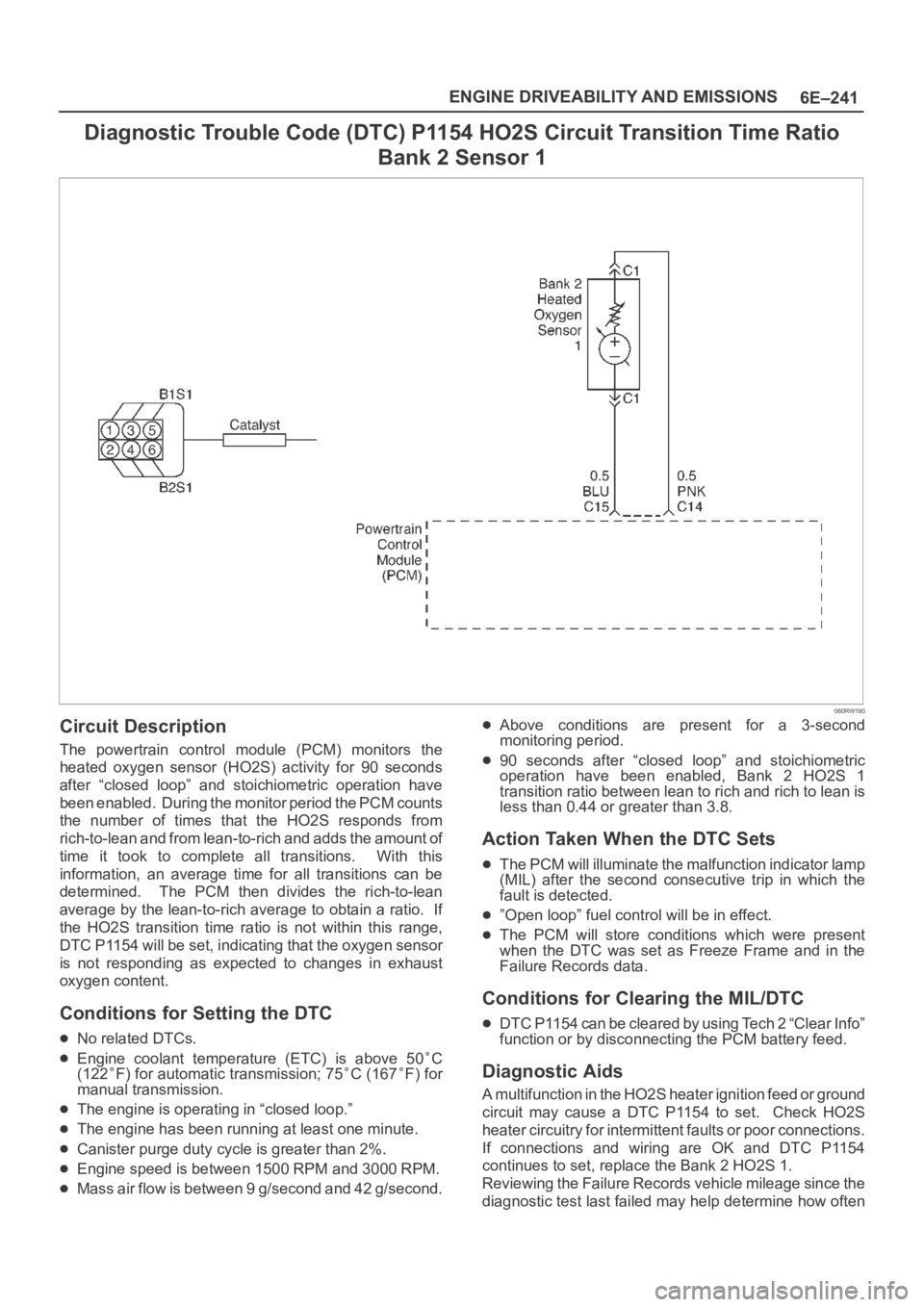
6E–241 ENGINE DRIVEABILITY AND EMISSIONS
Diagnostic Trouble Code (DTC) P1154 HO2S Circuit Transition Time Ratio
Bank 2 Sensor 1
060RW190
Circuit Description
The powertrain control module (PCM) monitors the
heated oxygen sensor (HO2S) activity for 90 seconds
after “closed loop” and stoichiometric operation have
been enabled. During the monitor period the PCM counts
the number of times that the HO2S responds from
rich-to-lean and from lean-to-rich and adds the amount of
time it took to complete all transitions. With this
information, an average time for all transitions can be
determined. The PCM then divides the rich-to-lean
average by the lean-to-rich average to obtain a ratio. If
the HO2S transition time ratio is not within this range,
DTC P1154 will be set, indicating that the oxygen sensor
is not responding as expected to changes in exhaust
oxygen content.
Conditions for Setting the DTC
No related DTCs.
Engine coolant temperature (ETC) is above 50C
(122F) for automatic transmission; 75C (167F) for
manual transmission.
The engine is operating in “closed loop.”
The engine has been running at least one minute.
Canister purge duty cycle is greater than 2%.
Engine speed is between 1500 RPM and 3000 RPM.
Mass air flow is between 9 g/second and 42 g/second.
Above conditions are present for a 3-second
monitoring period.
90 seconds after “closed loop” and stoichiometric
operation have been enabled, Bank 2 HO2S 1
transition ratio between lean to rich and rich to lean is
less than 0.44 or greater than 3.8.
Action Taken When the DTC Sets
The PCM will illuminate the malfunction indicator lamp
(MIL) after the second consecutive trip in which the
fault is detected.
”Open loop” fuel control will be in effect.
The PCM will store conditions which were present
when the DTC was set as Freeze Frame and in the
Failure Records data.
Conditions for Clearing the MIL/DTC
DTC P1154 can be cleared by using Tech 2 “Clear Info”
function or by disconnecting the PCM battery feed.
Diagnostic Aids
A multifunction in the HO2S heater ignition feed or ground
circuit may cause a DTC P1154 to set. Check HO2S
heater circuitry for intermittent faults or poor connections.
If connections and wiring are OK and DTC P1154
continues to set, replace the Bank 2 HO2S 1.
Reviewing the Failure Records vehicle mileage since the
diagnostic test last failed may help determine how often
Page 4900 of 6000
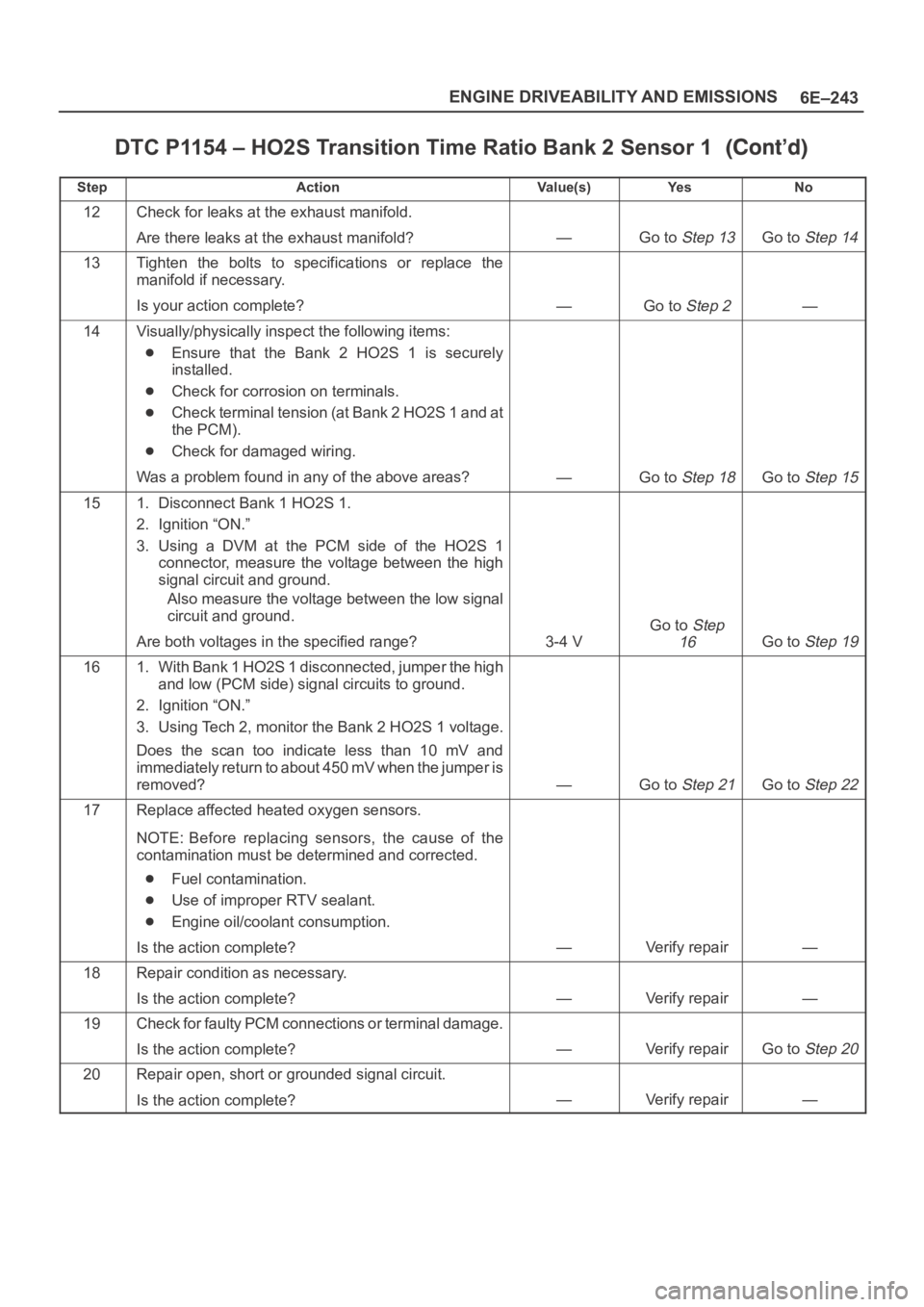
6E–243 ENGINE DRIVEABILITY AND EMISSIONS
DTC P1154 – HO2S Transition Time Ratio Bank 2 Sensor 1
StepNo Ye s Va l u e ( s ) Action
12Check for leaks at the exhaust manifold.
Are there leaks at the exhaust manifold?
—Go to Step 13Go to Step 14
13Tighten the bolts to specifications or replace the
manifold if necessary.
Is your action complete?
—Go to Step 2—
14Visually/physically inspect the following items:
Ensure that the Bank 2 HO2S 1 is securely
installed.
Check for corrosion on terminals.
Check terminal tension (at Bank 2 HO2S 1 and at
the PCM).
Check for damaged wiring.
Was a problem found in any of the above areas?
—Go to Step 18Go to Step 15
151. Disconnect Bank 1 HO2S 1.
2. Ignition “ON.”
3. Using a DVM at the PCM side of the HO2S 1
connector, measure the voltage between the high
signal circuit and ground.
Also measure the voltage between the low signal
circuit and ground.
Are both voltages in the specified range?
3-4 V
Go to Step
16
Go to Step 19
161. With Bank 1 HO2S 1 disconnected, jumper the high
and low (PCM side) signal circuits to ground.
2. Ignition “ON.”
3. Using Tech 2, monitor the Bank 2 HO2S 1 voltage.
Does the scan too indicate less than 10 mV and
immediately return to about 450 mV when the jumper is
removed?
—Go to Step 21Go to Step 22
17Replace affected heated oxygen sensors.
NOTE: Before replacing sensors, the cause of the
contamination must be determined and corrected.
Fuel contamination.
Use of improper RTV sealant.
Engine oil/coolant consumption.
Is the action complete?
—Verify repair—
18Repair condition as necessary.
Is the action complete?
—Verify repair—
19Check for faulty PCM connections or terminal damage.
Is the action complete?
—Verify repairGo to Step 20
20Repair open, short or grounded signal circuit.
Is the action complete?
—Verify repair—
Page 4905 of 6000
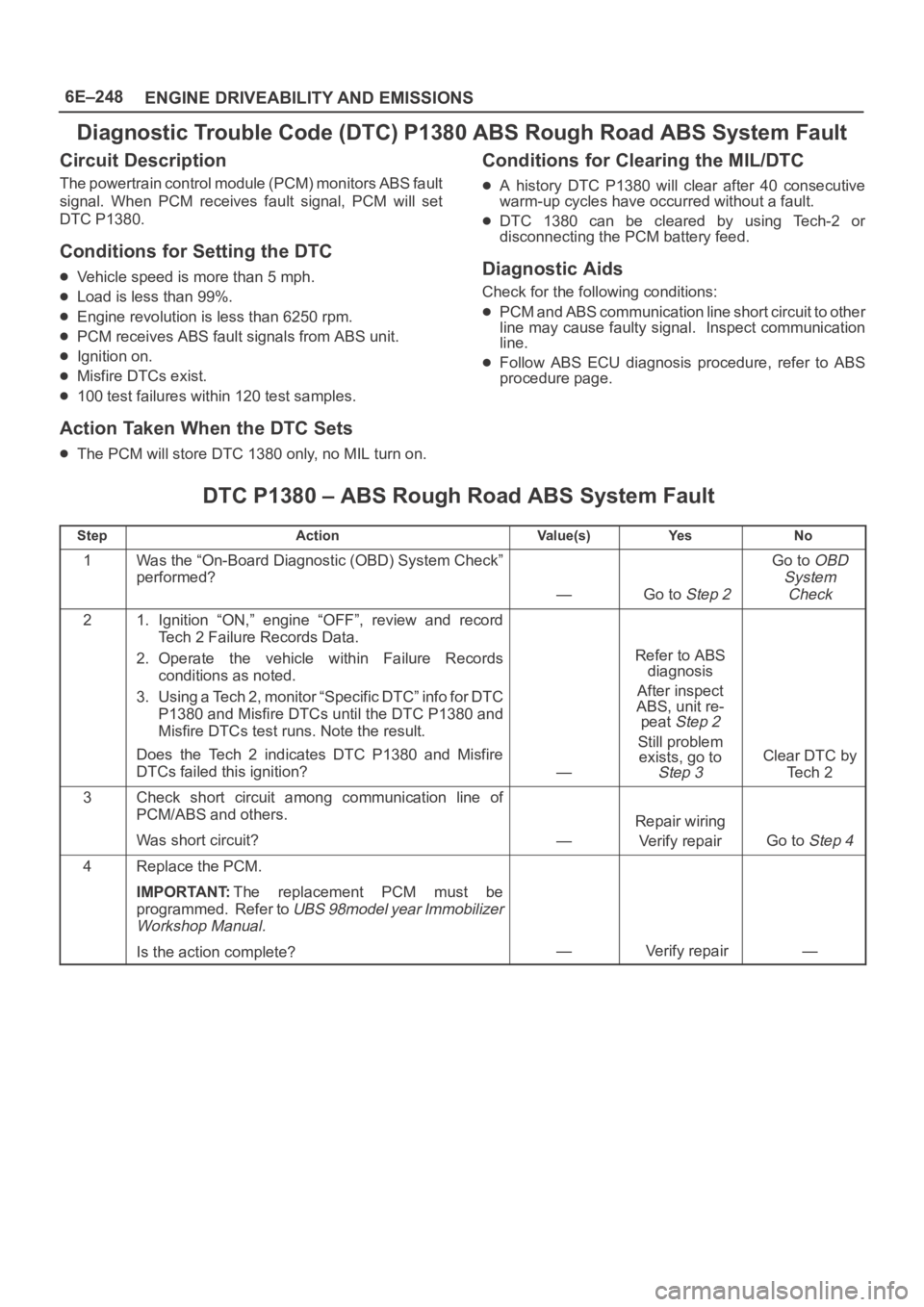
6E–248
ENGINE DRIVEABILITY AND EMISSIONS
Diagnostic Trouble Code (DTC) P1380 ABS Rough Road ABS System Fault
Circuit Description
The powertrain control module (PCM) monitors ABS fault
signal. When PCM receives fault signal, PCM will set
DTC P1380.
Conditions for Setting the DTC
Vehicle speed is more than 5 mph.
Load is less than 99%.
Engine revolution is less than 6250 rpm.
PCM receives ABS fault signals from ABS unit.
Ignition on.
Misfire DTCs exist.
100 test failures within 120 test samples.
Action Taken When the DTC Sets
The PCM will store DTC 1380 only, no MIL turn on.
Conditions for Clearing the MIL/DTC
A history DTC P1380 will clear after 40 consecutive
warm-up cycles have occurred without a fault.
DTC 1380 can be cleared by using Tech-2 or
disconnecting the PCM battery feed.
Diagnostic Aids
Check for the following conditions:
PCM and ABS communication line short circuit to other
line may cause faulty signal. Inspect communication
line.
Follow ABS ECU diagnosis procedure, refer to ABS
procedure page.
DTC P1380 – ABS Rough Road ABS System Fault
StepActionVa l u e ( s )Ye sNo
1Was the “On-Board Diagnostic (OBD) System Check”
performed?
—Go to Step 2
Go to OBD
System
Check
21. Ignition “ON,” engine “OFF”, review and record
Tech 2 Failure Records Data.
2. Operate the vehicle within Failure Records
conditions as noted.
3. Using a Tech 2, monitor “Specific DTC” info for DTC
P1380 and Misfire DTCs until the DTC P1380 and
Misfire DTCs test runs. Note the result.
Does the Tech 2 indicates DTC P1380 and Misfire
DTCs failed this ignition?
—
Refer to ABS
diagnosis
After inspect
ABS, unit re-
peat
Step 2
Still problem
exists, go to
Step 3
Clear DTC by
Te c h 2
3Check short circuit among communication line of
PCM/ABS and others.
Was short circuit?
—
Repair wiring
Verify repair
Go to Step 4
4Replace the PCM.
IMPORTANT:The replacement PCM must be
programmed. Refer to
UBS 98model year Immobilizer
Workshop Manual.
Is the action complete?—Verify repair—